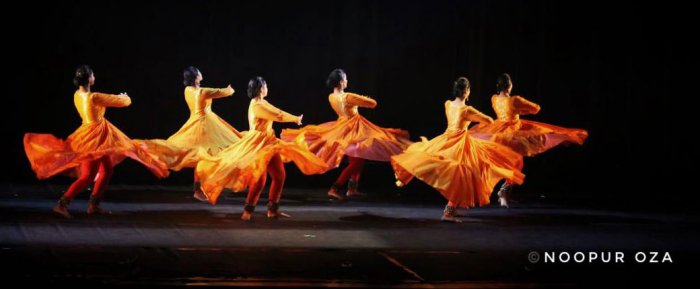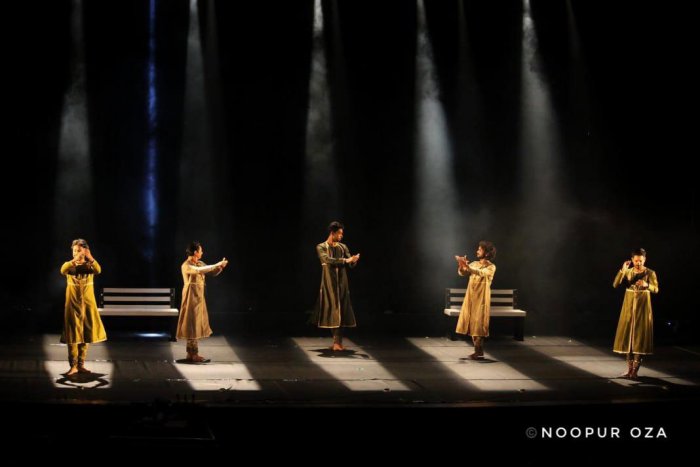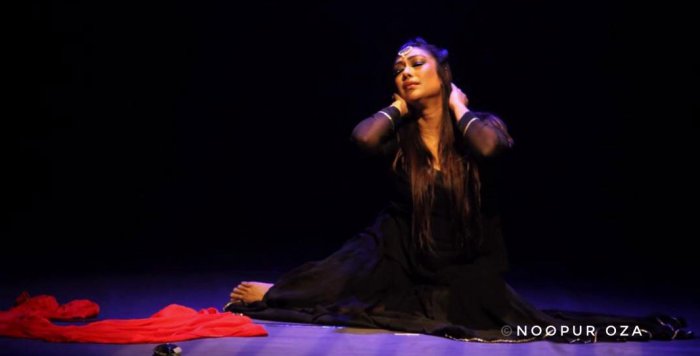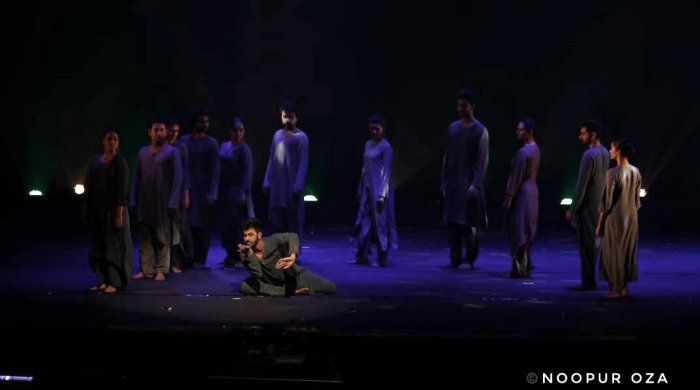
|   |

|   |
A narrative turns Kadamb's Meraki into a metaphor - Dr. S.D. Desai e-mail: sureshmrudula@gmail.com Photos: Noopur Oza February 1, 2019 Kumudini Lakhia gives a refreshing aesthetic touch to all details of her production and its presentation. Tied to the dainty invite to Meraki with the signature image of her lead dancer Sanjukta for the performance are three tiny ghunghru bells. The title Meraki given to Kadamb's new production (Pt Deendayal Auditorium, on Jan 30, 2019 at Ahmedabad) gets you to think of the very core, call it the soul, of Kathak, the dance form the choreographer, now at the threshold of nineties, has given an irresistible contemporary identity to.   With an element of a narrative built into her work, she gives the name Meraki to her modern Nayika, the counterpart of Radha, and turns it into a metaphor. Meraki is a young woman growing up with aspirations. With the fire in her heart not finding a creative outpouring in her formative years because of societal pressures and taboos, she feels turbulence within. Confused, she remains inhibited and withdraws into a shell. This subtle conflict finds an intricate expression on Sanjukta's face initially to strains from the Sarangi followed by a moving alaap. A mere suggestion made with her dupatta bearing a dominant red anticipates a greater, dramatic conflict. A friend, a counterpoint to her with traits of an extrovert, becomes a catalyst. Rupanshi as a Sakhi reaches out to Meraki with her sunny disposition and communicative body language. 'Look, the world is beautiful!' she seems to say. Dance and music have a delicate style, 'Itani araj mori maan, sakhi ri...' (Sawani Mudgal). In the next segment, the Nayika has an exposure to a cluster of girls (Rupanshi, Mitali, Mihika, Krutika, Manasi, Vidhi) all in their element individually and together - glowing with confidence and joy, uninhibited in their expression, happily interactive. The sarangi, tabla and the sitar enhance their youthful exuberance. Gyandev's lights give them an aura of sophistication. In the segment that follows, a boy (Rohit) notices Meraki sitting alone in a public place, feels attracted to her, gives signals of getting fond of her and though initially shy and reluctant she responds to him and gets closer. She seems to find moments of fulfillment, looks pleased with herself, but soon enough, realizing it is not 'proper', withdraws and exits. The male energy is now on display in a group of handsome young men (Mukesh, Abhishek, Mohit, Sanjejeet, Pankaj, Rohit, all invited) in varying dance formations including the delightful one with bols rhythmically gliding from dancer to dancer in a padhant. She has a momentary entry here for her to look at everyone admiringly. Meraki has gradually like rose petals opened up now, as her Sakhi had initially prompted. She is - Sanjukta with subtle abhinaya hints at it - anchored within with control, as a delicate female she attains alluring and yet dignified abandon. The dancer has an opportunity here to demonstrate all the artistry she is known for - a facial expression giving a glimpse within, intricate mudras weaving designs in the air, delightful chakkars in linear formations, a dazzling blend of measured and breathless pace and captivating footwork. Meraki has found her identity.   Does Meraki mark a watershed in Kadambís productions? From story-telling, Kumudini Lakhia had earlier turned to giving form to the abstract. Though there are elements of the abstract within segments, a narrative dances in here. With it, a rather shared perception is, the impact it leaves gets a shade fragile. Dr. S.D. Desai, a professor of English, has been a Performing Arts Critic for many years. Among the dance journals he has contributed to are Narthaki, Sruti, Nartanam and Attendance. His books have been published by Gujarat Sahitya Academy, Oxford University Press and Rupa. After 30 years with a national English daily, he is now a freelance art writer. |